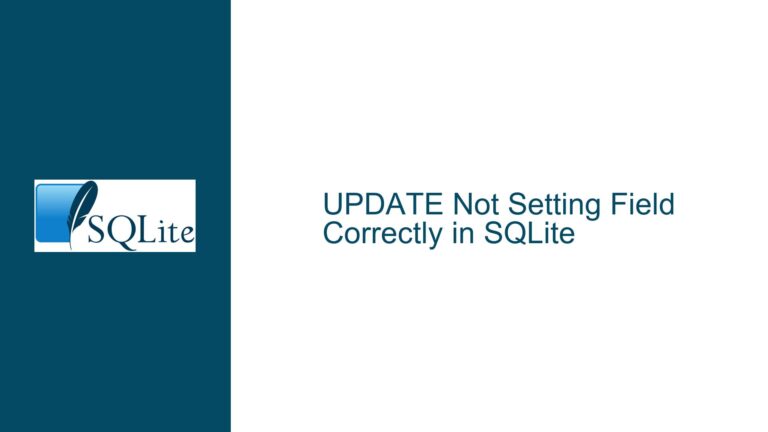and Resolving Unique Constraint Failures During Sequential Updates in SQLite
Issue Overview: Unique Constraint Violations Arising from Row Processing Order in Multi-Row Updates
The core issue revolves around a scenario where an UPDATE statement modifies a column (a_no) that has a UNIQUE constraint. The first two updates succeed, but the third fails with a UNIQUE constraint failed error. This discrepancy arises from how SQLite processes rows during an UPDATE operation and the interaction between the view (vparent) and the uniqueness constraint on a_no.
Key Components of the Problem:
- Table Structure: The
parenttable includes a columna_nowith aUNIQUEconstraint. Thevparentview assigns anew_a_novalue viarow_number() over (order by label)for active rows (active=1), while inactive rows (active=0) havenew_a_noset toNULL. - Update Mechanism: The
UPDATEstatement attempts to synchronizea_nowithnew_a_nofrom the view, but this process depends on the internal order in which SQLite processes rows during the update. - Unique Constraint Enforcement: SQLite checks the
UNIQUEconstraint for each row as it is updated, not after all updates are complete. This means intermediate states during the update can violate the constraint if overlapping values are temporarily assigned.
Why Update 3 Fails:
- In Update 3, after reactivating the row with
label='b', thevparentview assignsnew_a_no=2to this row. However, the row withlabel='c'already hasa_no=2from the previous update. - SQLite processes the
UPDATEin an unspecified order. If it updateslabel='b'beforelabel='c', the assignmenta_no=2tolabel='b'will conflict withlabel='c'’s existinga_no=2, triggering the unique constraint error. - In contrast, Updates 1 and 2 worked because either all
a_novalues were initiallyNULL(no conflicts) or the processing order avoided overlapping assignments.
Hidden Complexity in the View:
The vparent view uses a UNION to combine active and inactive rows. The row_number() window function is applied only to active rows, but the ORDER BY label in the UNION’s outer query can affect the numbering when rows are added or reactivated. For example, reactivating label='b' shifts the numbering for subsequent labels (c and e), creating potential overlaps during updates.
Possible Causes: Row Processing Order and Constraint Checking During Updates
1. Non-Deterministic Row Processing Order in SQLite
- SQLite does not guarantee a specific order for processing rows in an
UPDATEstatement. The order is determined by the internal storage mechanism (e.g., rowid order or index traversal). This non-determinism means that overlappinga_noassignments can occur if the update sequence is not carefully controlled. - Example: If SQLite processes
label='b'beforelabel='c'in Update 3,a_no=2is assigned tolabel='b'whilelabel='c'still holdsa_no=2, violating the unique constraint.
2. Intermediate Constraint Violations During Multi-Row Updates
- SQLite enforces constraints immediately after each row is updated, not at the end of the transaction. This means that even if the final state of the table would satisfy all constraints, intermediate states during the update can fail.
- In Update 3, the conflict between
label='b'andlabel='c'occurs because SQLite checks the constraint after updatinglabel='b'but before updatinglabel='c'.
3. Dependence on the vparent View’s Output
- The
vparentview dynamically calculatesnew_a_nobased on the current state of theparenttable. When multiple rows are updated in a single statement, the view’s output can change mid-update, leading to inconsistent assignments. - For example, reactivating
label='b'changes therow_number()sequence for active rows, but theUPDATEstatement references the view’s output as it exists at the start of the update. This creates a race condition if the view’s results are not static during the update.
4. Lack of Deferrable Constraints
- SQLite does not support deferrable constraints. If it did, the unique constraint could be deferred until the end of the transaction, allowing temporary violations during the update. Without this feature, the update must avoid conflicts at every step.
Troubleshooting Steps, Solutions & Fixes: Ensuring Safe Updates with Unique Constraints
Step 1: Diagnose the Root Cause
- Check the Current State Before Updates: Use
SELECT * FROM parent ORDER BY label;to verifya_novalues and ensure no duplicates exist before running the update. - Simulate the Update Manually: Execute the update logic row-by-row in the suspected processing order (e.g., ascending vs. descending
labelorder) to identify conflicting assignments.
Step 2: Implement Workarounds to Avoid Intermediate Conflicts
Solution 1: Clear a_no Before Updating
- Approach: Set all
a_novalues toNULLbefore assigning new values. This ensures no duplicates exist during the update.UPDATE parent SET a_no = NULL WHERE active = 1; UPDATE parent AS p SET a_no = v.new_a_no FROM vparent AS v WHERE p.label = v.label AND p.active = 1; - Pros: Eliminates conflicts by starting with a clean slate.
- Cons: Increases write operations, which may impact performance on large tables.
Solution 2: Use a Temporary Table for Staging New Values
- Approach: Store the target
a_novalues in a temporary table and updateparentfrom this table.CREATE TEMP TABLE staging AS SELECT label, new_a_no FROM vparent WHERE active = 1; UPDATE parent AS p SET a_no = ( SELECT new_a_no FROM staging AS s WHERE p.label = s.label ) WHERE p.active = 1; - Pros: Decouples the calculation of
new_a_nofrom the update process, avoiding mid-update shifts in the view’s output. - Cons: Requires additional storage for the temporary table.
Solution 3: Control Update Order with a Subquery
- Approach: Force SQLite to process rows in a specific order using a subquery with
ORDER BY.UPDATE parent AS p SET a_no = ( SELECT new_a_no FROM vparent AS v WHERE p.label = v.label ) WHERE p.label IN ( SELECT label FROM parent WHERE active = 1 ORDER BY label DESC -- Process rows in reverse label order ); - Pros: Reduces the likelihood of conflicts by controlling the update sequence.
- Cons: SQLite may ignore the
ORDER BYclause in the subquery, making this approach unreliable.
Step 3: Redesign the Schema or Logic for Deterministic Updates
Fix 1: Replace the View with a Generated Column
- Approach: Use a generated column to calculate
a_noon the fly, eliminating the need for manual updates.ALTER TABLE parent ADD COLUMN a_no GENERATED ALWAYS AS ( CASE WHEN active = 1 THEN row_number() OVER (ORDER BY label) ELSE NULL END ) VIRTUAL; - Pros: Automates
a_nocalculation and ensures consistency. - Cons: SQLite does not support generated columns with window functions (as of 3.41.2).
Fix 2: Use Triggers to Maintain a_no
- Approach: Create triggers that update
a_nowhenever a row is inserted or modified.CREATE TRIGGER update_a_no AFTER UPDATE OF active ON parent BEGIN UPDATE parent SET a_no = ( SELECT row_number() OVER (ORDER BY label) FROM parent AS p2 WHERE p2.active = 1 AND p2.label <= parent.label ) WHERE active = 1; END; - Pros: Ensures
a_nois always up-to-date without manual intervention. - Cons: Triggers can introduce complexity and performance overhead.
Fix 3: Use a Procedural Approach with Application Logic
- Approach: Calculate
a_novalues in the application layer and update rows individually in a controlled order.# Pseudocode labels = execute("SELECT label FROM parent WHERE active = 1 ORDER BY label") for index, label in enumerate(labels, start=1): execute("UPDATE parent SET a_no = ? WHERE label = ?", (index, label)) - Pros: Full control over the update order and conflict avoidance.
- Cons: Requires moving logic out of the database, which may not be desirable.
Step 4: Validate the Solution Against the Original Constraints
- Test Case 1: Reactivate a row and ensure the update processes rows in an order that avoids conflicts (e.g., updating higher labels first).
- Test Case 2: Verify that all
a_novalues are unique after updates usingSELECT a_no, COUNT(*) FROM parent GROUP BY a_no HAVING COUNT(*) > 1;.
By understanding the interplay between SQLite’s update mechanics, constraint enforcement, and view dynamics, you can implement robust solutions that prevent unique constraint violations. Each approach has trade-offs in complexity, performance, and maintainability, so choose the one that best aligns with your application’s requirements.






